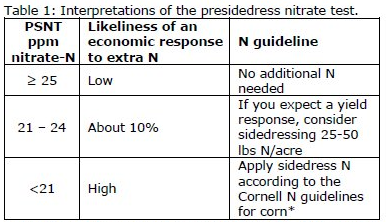The Pre-sidedress Nitrate Test (PSNT) is an in- season soil nitrate test that can be used to determine if additional fertilizer nitrogen (N) is needed for corn.
This test should be conducted on soil samples taken just prior to sidedressing (just before the period of major N demand by corn). The test can be done for fields with a history of manure and/or sod incorporation.
The PSNT is designed to: (1) estimate the soil’s nitrate supplying potential, and (2) decide if that is enough N to meet crop needs.
When to use:
-
In corn fields, 2nd year or more after a sod and/or where the manure rate is uncertain.
- If not enough manure was applied to meet the expected N needs of the crop.
Where not to use the PSNT:
-
The test is useless for corn fields that received pre-plant or early post-plant broadcast fertilizer N applications (other than <40 lbs starter N/acre in the band). Any “leftover” nitrate from broadcast fertilizer that is measured by the PSNT could overestimate the true nitrate supplying potential.
-
First year corn after a grass sod with adequate starter N (20-30 lbs N/acre) is not likely to need additional N. Only a few soils in New York State (i.e. those with the highest yield potentials: Hamlin, Genesee, Hartland, Ross) would show a yield response to a moderate sidedress N rate after a grass sod.
- First year corn after a grass/alfalfa stand rotated to corn is unlikely to respond to sidedress N because sufficient amounts of N will be available from the plowed-down sod. It is a waste of time and money to sidedress N in these situations so it is also not necessary to take a PSNT.
How to take samples?
For accurate results, 2nd or higher year corn fields should be sampled for PSNT according to the following procedure:
- Limit sample to areas of 15 acres or less and take a separate sample for areas with different corn stands (different population densities, stage of development, and/or color), crop histories, fertility management, significant changes in slope, etc.
- Sample between corn rows to a depth of 12 inches (stay away from the starter band).
- Sample when the corn is 6-12 inches tall.
- Do not sample too close to a rain event that could have resulted in nitrate leaching (wait for 2-3 days after significant rainfall).
Samples should be dried immediately (spread the sample thinly and dry in the sun or under a fan) to stop N mineralization and sent to the laboratory. Most laboratories that conduct PSNT analyses will guarantee a 24-hour turnaround time.
If you use a Cardy Nitrate Meter:
- Use fresh reagents and frequently re-calibrate with the standard solutions supplied with the meter.
- At the beginning of the season, test a few soil samples and send duplicates to a reliable laboratory to check on performance of the meter. This could prevent surprises at PSNT time.
- For a user manual of Cardy nitrate meter: www.specmeters.com/pdf/2300%20CARDY%20NO3%20Meter.pdf. Make sure to read the manual prior to use of the meter.
Interpreting PSNT results:
The PSNT guidelines for those fields with ≥25 ppm or 21–24 ppm are straightforward:

|
For fields with <21 ppm:
-
If you took a PSNT on a field that you expected to need sidedress N (for example a field that received less manure than needed to meet N needs), add the extra N.
- If you took a PSNT on a field that you expected to not require sidedress N (for example where manure applications should have supplied sufficient N), make sure the field actually received the planned manure application and that the field history is correct. Check N needs with the NYS Corn N Calculator. If the calculator shows that no additional N is needed, despite the PSNT being <21 ppm, organic-N mineralization rates early in the season were likely lower than average. No additional N is needed because the field is expected to supply sufficient N from organic sources once mineralization conditions improve (warm and moist soils). If the calculator shows that additional N is needed, consider adding the extra N fertilizer.
The PSNT is particularly useful when it is unclear whether enough manure was actually applied. Over the course of a few years, carefully compare PSNT results with fertilizer and manure inputs and crop performance to develop the skills and local experience to best use this test.
If you decide to sidedress but want to check if the additional N is (was) needed:
-
Leave untreated check strips in the field.
-
At harvest time evaluate the strips visually: if the leaves are green to the bottom of the plant, it is likely that too much N was applied. Many users will be very uneasy with this, but yield is not suppressed when about 3 leaves or so from the ground up are yellow at harvest time. See the 2005 Cornell Guide for Integrated Field Crop Management (“Nitrogen Status of the Corn Crop” on page 56) for more discussion.
-
Check the yield: harvest and weigh at least two rows of 17.5 feet (1/1000th of an acre with 30 inch rows) in each treatment and determine dry matter to correct for moisture differences.
- Conduct a corn stalk nitrate test (CNST) at harvest time. This test is an end-of-season “report card” for N management.






Post a comment
Report Abusive Comment